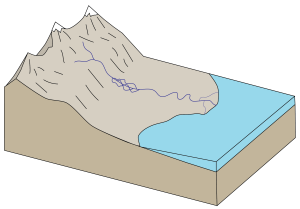Lab 5 Exercises
The exercises below will guide you through the sedimentary rock samples in Rock Kits 1 and 2. Review the background information presented in Chapters 5.1 to 5.3 before you begin these exercises. You may wish to consult the Rock Classification Tables at the back of this manual as you complete the exercises below.
Tips for Classifying Sedimentary Rocks
- Your first step when examining any sedimentary rock is to determine if its texture is clastic or crystalline.
- If the texture is clastic, next determine the predominant size of the grains by looking closely through your hand lens and using the grain size chart (see Table A in the Rock Classification Tables appendix).
- Next, describe the sorting, and the shape (roundness) of the grains (Figure C in the Rock Classification Tables appendix). Remember that you are not describing the shape or size of the sample, but of the grains within it!
- If the texture is crystalline, test the sample with a drop (only a drop!) of dilute HCl. If the rock reacts with HCl, look carefully to determine what exactly is reacting (e.g., cement between grains of quartz sand? The entire sample of limestone?).
- Quartz grains come in many colours, but always have vitreous lustre.
- Feldspar grains are commonly white or pink in colour, and in very coarse-grained clastic sedimentary rocks, you may even see feldspar grains broken along cleavage planes. Feldspar grains that have been chemically weathered tend to look chalky and dull, which can help you differentiate them from quartz grains.
1. Using your hand lens, carefully examine samples R151, R161, R162, and R181 from your Rock Kit to complete the table below. The example provided indicates the level of detail expected of your observations.
| Sample # | Grain Size (mm) | Energy Level | Roundness | Sorting | Composition (grains and cement) | Rock Name |
| Example | 0.5-2 mm (sand) | Moderate | Sub-rounded | Moderately sorted | 65% quartz, 35% rock fragments, calcite cement | Lithic arenite |
| R151 |
|
|
|
|||
| R161 |
|
|
|
|||
| R162 |
|
|
|
|||
| R181 |
|
|
|
2. Are all four samples in the table above chemical or detrital (clastic) in origin? How can you tell?
3. Indicate where on the diagram each of the samples from the table above is most likely to have formed by considering the grain size, roundness, sorting, and composition.

4. Imagine a large granite pluton has been uplifted and exposed at the surface. Imagine that this granite is the source material for samples R161 and R162.
a) List the minerals you would expect to find in this granite, and their typical weathering products.
b) If these two samples originated from the same source material, explain what process(es) are responsible for the key difference(s) between them? Hint: examine your answers in the table above.
5. Examine rock samples RI91, R201, R211, R221, R231, R251, R261, R271, and R281. In the table below, name the mineral and rock(s) from your rock kits that correspond to the composition provided. As you examine each rock sample, think about what physical properties the mineral and the rock have in common. You may want to review the physical properties of minerals summarized in Labs 2 and 3, and in the mineral identification tables.
| Composition | Mineral Name | Rock Sample # | Rock Name | Diagnostic Properties Common to Both Rock and Mineral |
| CaCO3 |
|
|
||
| SiO2 |
|
|||
| NaCl |
|
|||
| CaSO4·H2O |
|
|||
| C (mostly) | N/A |
|
6. Examine sample R201. What shape are the grains?
7. The small rounded grains that you see are called ooids, and the textural term for a rock with ooids is .
8. How do you think the ooids formed?
9. Name this rock:
10. Examine sample R211. Look closely at the larger grains. What would be a more appropriate term than ‘grains’?
11. What is the main component of the rock?
12. Compare samples R211 and R221. How are these two samples similar? How do they differ, and how would you distinguish one from the other?
13. Examine sample R231. Scratch this sample with your fingernail. Why does it seem so much softer than a crystal of calcite?
14. Examine sample R251. The black colour is due to the very high organic content of the rock. This type of rock is combustible. Name this rock:
15. How does this type of sedimentary rock form?
16. Examine samples R271 and R281. In what ways do these two different samples differ?
17. Simple observations about composition and texture of a rock sample can give a geologist important clues about the ancient environment in which a sedimentary rock formed. Use your observations of sedimentary rock samples R151, R161, R181, R221 and R281, and the information provided in Chapter 5.3 to complete the table below. You should find more than one possible depositional environment for most samples.
| Sample | Possible environment(s) of deposition | Evidence |
| R151 |
|
|
| R161 |
|
|
| R181 |
|
|
| R281 |
|
|
| R221 |
|
|
Media Attributions
- Figure A: © Siobhan McGoldrick. CC-BY-4.0.

